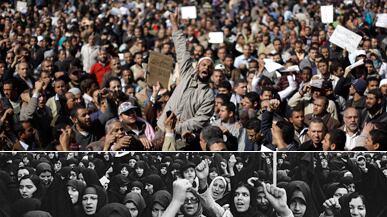The Egyptian protests bear an uncanny resemblance to the 1979 Iranian revolution, but historian Geoffrey Wawro urges the U.S. to learn the lessons of supporting a dictator—or risk losing Egypt to the Muslim Brotherhood. Plus, full coverage of the Egyptian protests.
So far the Obama administration seems to be getting it right on Egypt. The president has called for an “ orderly transition,” and Secretary of State Hillary Clinton has warned there must not be “a takeover that would lead to oppression,” a clear reference to Egypt’s Muslim Brotherhood.
Photos: Egypt Protests
ADVERTISEMENT

More than just the right words will be needed. The Obama team should be looking closely at Washington’s awful mismanagement of the Iranian revolution of 1978-79 to make sure they do not repeat the errors of the Carter administration.
The revolutions in Cairo and Tehran have much in common. Both simmered under the rule of corrupt strongmen who had held power for three decades. Both were triggered by new media—audiocassettes in Iran, Twitter and Facebook in Egypt—and both exploded in major regional states, with big populations, strong internal security services and powerful, U.S.-supplied militaries. Both dynasts, Hosni Mubarak and Shah Muhammed Reza Pahlavi, were regarded in Washington as “family friends,” to borrow Hillary Clinton’s phrase. Both had complex societies, with big swollen cities like Cairo and Tehran containing both the most and least educated people in the country: a relatively narrow educated elite and a broad mass of slum-dwellers. The strategic threat of that—then and now—was outlined by the U.S. ambassador in Tehran in 1970, when he predicted, with astonishing accuracy, just how Iranian demographics would shape the coming upheaval. Since most Iranians were “poorly educated and highly ignorant,” any truly democratic movement would “be in a reactionary obscurantist direction under the clergy.”
The Carter administration was as startled by the revolution in Tehran as Obama was by the wave of revolutions from Tunis to Cairo. Just before the regime began to totter in 1978, Carter’s CIA had predicted that nothing much would change in Iran through 1985: “Iran is not in a revolutionary or even pre-revolutionary situation.” As Carter reacted to events in Iran, rifts in the U.S. government confused and demoralized him, and prevented Washington from acting swiftly and decisively to steer the Iranian revolution in a moderate direction.
Iranian generals met with the U.S. ambassador in Tehran, William Sullivan, and expressed their willingness to launch a coup to keep the shah in power, or even topple the shah, purge the fundamentalist opposition, and set up a moderate caretaker government.
Such a plan, which held the most promise in late 1978, was undone by fights between Cyrus Vance’s State Department and Zbigniew Brzezinski’s National Security Council. State thought the shah was doomed and that Washington needed to reach some accommodation with the Khomeini camp; Brzezinski (joined by Defense Secretary Harold Brown and Energy Secretary James Schlesinger) thought the shah might relinquish some domestic authority, but must hold on to police powers and military and foreign affairs. Just as we today worry that fundamentalists might hijack the Tunisian, Egyptian, Jordanian, and Lebanese emergencies, Brzezinski spoke of an “arc of crisis” in the Middle East—a wave of unrest in Islamic countries, beginning with Iran—that the Soviets might hijack.
Administration hardliners wanted the shah to “get tough,” to re-arrest political prisoners, to shut down the press, and to flood the streets with troops and tanks. But decades of repression and fake elections had crushed Iran’s secular parties; there was no credible moderate opposition to undergird a generals’ coup. Only the Shiite clergy—like the Muslim Brotherhood in Egypt—remained intact and powerful as a political force.
In December 1978, Carter appointed 68-year-old George Ball to sift through conflicting reports to determine just what the U.S. ought to do about Iran. Ball worked hard for two weeks, read classified and unclassified reports from all sources, and then met with Carter to render his verdict. The shah was finished, vomited out in “a national regurgitation by the Iranian people.” America’s wisest course now would be to “work out the transfer of power to responsible hands before Khomeini comes back and messes everything up.”
Ball urged Carter to tell the shah to leave Iran, turn affairs over to a reliable government, and serve as a distant “regent” until things cooled down. Carter expressed astonishing diffidence. “I can’t tell another head of state what to do,” Carter protested. “You can tell a friend what you think,” Ball persisted. “One of the obligations of friendship is to give advice, particularly to a man who is cut off from the normal sources, who is surrounded by sycophants.” Carter refused to have that conversation with the shah. Fortunately, Obama is speaking bluntly with Mubarak about the need for change.
Noting Carter’s hesitation, Brzezinski reopened his attack. The president must prop up the shah, to reassure allies and deter the Soviets. “Geopolitics is not a kindergarten class,” he reminded the president. Ball’s moderates were used-up hacks who wouldn’t stand a chance against Khomeini’s mobs. No, the U.S. would have to vest its hopes in the Iranian military, which was still loyal to the shah. Brzezinski drafted a letter for Carter to send to the shah that baldly enjoined him to use force against the demonstrators. Vance was horrified, and warned Carter that Brzezinski was recommending a course that would end in “1,000 deaths,” others thought tens of thousands. The letter was never sent.
Another wave of riots swept through Tehran in January 1979. Carter sent General Robert Huyser to speak with the senior Iranian generals and gauge their attitude. What Huyser discovered was interesting. The generals feared the Islamists, but also moderates, who they assumed would open corruption investigations that would lead back to the military. The seven Iranian generals Huyser met with expressed their readiness to kill “100,000 Iranians” if necessary, to restore the shah or an authoritarian regime. What they needed—all seven declared—was unflinching U.S. backing.
Today in Cairo, President Obama is facing similar hard choices. The error in Tehran in 1979 was one of omission. Frozen by opposing views, Washington did nothing. When the shah left Iran in January 1979 to have his cancer treated, pro-Khomeini demonstrations broke out in every Iranian city. Although Brzezinski and Brown in Washington and General Alexander Haig at NATO headquarters in Belgium were still for unleashing the Iranian military against the ayatollahs—“give the officers a go-ahead,” Brown urged Brzezinski—Carter refused to roll the dice.
Carter decided that Iran was Khomeini’s. It wasn’t. The president still effectively controlled the Iranian generals and might have fashioned a moderate reform coalition under their aegis. Instead, Carter selected a negative program: merely cultivating contacts with moderate Islamic clergy, officers, and politicians in the vain hope that they would counter Khomeini’s radicalism and step in if the ayatollah’s movement unraveled.
Just as Egyptian fighter jets are orbiting Cairo in a show of strength, the Iranian air force did the same in early February 1979. The imperial military’s hour had seemingly arrived. Khomeini’s komitehs—Islamic militias and revolutionary courts—were rounding up the shah’s courtiers. The generals made a last appeal to Ambassador Sullivan for support; he relayed the request to Washington, but Carter remained inert, refusing even to dispatch a carrier to the Persian Gulf.
The Iranian generals threw in the towel. Sullivan cabled Washington on February 27, warning that anti-American sentiment was boiling over in the streets and the press, and that the U.S. Embassy could no longer be protected. He and his subordinates recommended the embassy staff be reduced to “six officers and a vicious dog.” (When the embassy was actually seized eight months later, Carter must have wished he had heeded the warning.) With Washington in retreat, the generals declared “neutrality”; most were arrested, exiled, or shot. The army stood down and let the demonstrations disarm it. “In Iran, all our investment in an individual, rather than in a country, came to naught,” an American colonel named Colin Powell observed from the Pentagon. “When the shah fell, our Iran policy fell with him.”
The hand we played in 1979 was self-nullifying, and helped usher in the Islamic Republic of Iran, which has vexed and weakened American policy for more than 30 years.
President Obama is now holding our Egypt policy in his hands. He must move fast and deal bluntly with President Mubarak. The Egyptian army must be restrained; credible opposition moderates like Mohamed ElBaradei must be empowered to move the country forward without a breakdown in security or an Islamist coup. Mubarak should turn power over to a respected politician bolstered by Omar Suleiman’s reformed security services, who will loosen their grip but not permit the Muslim Brotherhood to knock over a “national unity government” as easily as Khomeini crushed Iran’s first, mixed “provisional revolutionary government.” None of this will be easily accomplished, and America has only an auxiliary role. But the hand we played in 1979 was self-nullifying, and helped usher in the Islamic Republic of Iran, which has vexed and weakened American policy for more than 30 years.
Dr. Geoffrey Wawro is the General Olinto Mark Barsanti Professor of Military History and Director of the Military History Center at the University of North Texas. He is the author of Quicksand: America’s Pursuit of Power in the Middle East (Penguin Press, 2010.)






